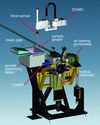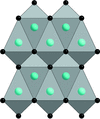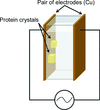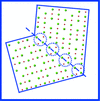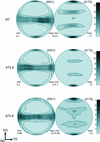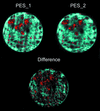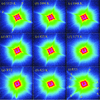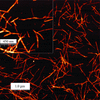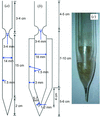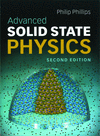issue contents
February 2013 issue

Cover illustration: A schematic of a new X-ray scattering geometry, grazing-incidence transmission small-angle X-ray scattering. The incident beam impinges on the edge of a nanostructured surface at a grazing angle, and exits through the sample's edge. The method is demonstrated for gratings where it is shown that the Born approximation is valid with a simple and small correction. Courtesy of Lu et al. [J. Appl. Cryst. (2013), 46, 165-172].
research papers
Open  access
access
 access
accessThe SIBYLS beamline of the Advanced Light Source at Lawrence Berkeley National Laboratory is a dual endstation small-angle X-ray scattering and macromolecular crystallography beamline. Key features and capabilities are described along with implementation and performance.
Download citation


Download citation


A new orthorhombic high-pressure phase of NiSi has been synthesized in a multi-anvil press at 1223–1310 K and 17.5 GPa. Its crystal structure has been determined and found to be closely related to that of a tetragonal form of NiSi predicted previously to be stable at high pressure by ab initio computer simulations.
It has been observed that the FWHMs of X-ray rocking-curve profiles for crystals grown with an external electric field are smaller than those for crystals grown without. These results indicate that the crystal quality of hen egg white lysozyme crystals could be improved by application of an external alternating current electric field during growth.
In a proof-of-principle polarized neutron Laue diffraction experiment it is shown that the featureless incoherent background due to hydrogen can be uniformly reduced by means of dynamic nuclear polarization of the proton spins, while the intensities of the Laue reflections can be enhanced or diminished significantly.
The design of a neutron-focusing instrument with a combination of parabolic and elliptical supermirrors is presented and its performance is described.
The ordering of carbon vacancies induces the reduction of twinning interfacial energy and leads to the presence of {111} twinning structures in nonstoichiometric ZrC0.6. Two types of twinning boundaries, i.e. {111}C and {111}Zr, can be recognized.
Defects in the core of SrLaGaO4 single crystals were studied by transmission X-ray diffraction topography. The contrast of the defect images was analysed for various diffraction conditions and as a function of absorption. The results of the analysis confirm the model of crystal lattice deformation around rod-like volume defects in SrLaGaO4 crystals.
The substructure in terms of dislocation densities and prevailing slip-system types is determined by the method of X-ray line profile analysis in two different texture components of an AZ31-type Mg-base alloy after extrusion and subsequent tensile deformation at different temperatures.
Open  access
access
 access
accessThe concept of the directional pair distribution function is proposed for an atomistic level interpretation of the line profile broadening in powder diffraction patterns of nanocrystalline materials.
The resonant anomalous X-ray reflectivity of complex oxide thin films is described.
The ideal asymptotic probability density function and the exact probability density function of the normalized structure factor are compared and a program for normalized structure factor analysis is described.
Preferred orientation correction of a fiber texture in asymmetric coplanar diffraction conditions is considered, with particular application to glancing-incidence X-ray scattering.
Download citation


Download citation


An efficient method for modelling a polytypic family is presented with the example of cimetidine in the form C polymorph. The method exploits the (3 + 1)-dimensional superspace model, which is a powerful tool for the description, prediction and understanding of polytype modifications in small-molecule crystallography, as illustrated with this pharmaceutical example.
Open  access
access
 access
accessA systematic analysis of diffraction data of 11 different lysozyme crystals (used for cisplatin and carboplatin binding studies), obtained with four diffraction data processing software packages and from two different diffractometers, serves as a pilot study for archiving raw diffraction data and associated metadata. The availability of the raw diffraction images allows for independent assessment of software packages.
High-resolution X-ray diffraction in coplanar and noncoplanar geometries has been used to investigate the influence of an SiNx nano-mask in the reduction of the threading dislocation density of high-quality AlGaN epitaxial layers grown on sapphire substrates.
A new type of high-resolution neutron monochromator based on multiple reflections realized in bent perfect crystals of Si and Ge was tested. By means of multiple reflections, a highly collimated and simultaneously highly monochromatic beam of rather large cross section can be obtained.
Orientation relations between the ferritic, austenitic and σ-phase grains in duplex stainless steels were converted into mathematical (matrix) expressions and these expressions were confirmed by automated electron backscatter diffraction measurements of the orientations of single grains.
Improved data collection and analysis strategies concerning the `pencil-beam' synchrotron X-ray diffraction tomography technique have been used to obtain quantitative information about the spatial distribution and time evolution of all the phases present in complex systems, such as hydrated cement samples.
The underlying techniques and capabilities of submicrometre-resolution three-dimensional X-ray microscopy (3DXM) are reviewed. The major applications and accomplishments of 3DXM are discussed through selected examples, including investigations of local elastic strain, plastic strain, crystal structure, phase changes and microstructure evolution.
A new scattering geometry, grazing-incidence transmission small-angle X-ray scattering, is introduced. With this geometry the incident beam is at a grazing angle well above the critical angle and the scattered beam exits through the edge of the substrate. This geometry validates the Born approximation.
Improvements to the experimental setup, the data collection strategy and the data analysis procedure have simplified the method for exploiting preferred orientation in the structure analysis of polycrystalline materials.
The evolution of the size distribution of (Fe,Cr) carbides and the dislocation structure in low-chromium steel is studied during quenching and rapid heating by in situ small-angle X-ray scattering (SAXS). From simulations based on the theory of SAXS from dislocations, it is shown that the measured streaks in the two-dimensional SAXS patterns correspond to a dislocation structure of symmetric low-angle tilt boundaries, which in turn corresponds to the crystallographic orientation gradient in the single crystal of ferrite as measured by three-dimensional X-ray diffraction microscopy.
Download citation


Download citation


High-energy X-ray scattering data from turbostratic phyllomanganate nanosheets are analyzed in real-space by pair distribution function analysis and in reciprocal space by the Bragg-rod method and the Debye equation. The elastic deformation of the two-dimensional nanocrystals is modeled with (1) a new empirical strain function in Bragg-rod calculations and (2) explicit spherical and cylindrical mandrels implemented in the Debye equation.
A new approach is presented for calculating the parent orientation from sets of variants of orientations produced by phase transformation.
The crystallographic orientation of β-eucryptite dendrites has been analysed by the electron backscatter diffraction technique, and a twin relationship and a topotactic relationship between dendrites have been found. The twin index n = 2 and the obliquity ω = 3.2877°.
Various models to describe small-angle neutron scattering data from helices of amyloid protofilaments (hen egg white lysozyme) in solution were analyzed. The found parameters were compared with those obtained by atomic force microscopy of the dried adsorbed state of amyloid fibrils.
cryocrystallography papers
A new crystal-hydration method has been developed for high-pressure cryocooling of protein crystals.
teaching and education
Free 

A worked example of polytypism is presented to motivate undergraduates in the study and instructors in the teaching of this crystallography topic.
short communications
The spreadsheet described provides much necessary information for undertaking and interpreting least-squares refinements on crystals twinned by merohedry.
computer programs
ABSORB, a program to calculate and apply absorption corrections to single-crystal X-ray intensity data, has been reconfigured to allow it to be called directly from external data processing programs. ABSORB-GUI has been developed to allow much easier specification of standard experiments.
SrRietveld, a Python-based Rietveld refinement program, is described. SrRietveld extends and automates the popular existing Rietveld programs FullProf and GSAS to facilitate studies that involve many refinements, such as the analysis of large numbers of data sets.
ReX.Cell is a multi-platform open-source program aimed at the automation of powder diffraction data indexing, providing an interactive environment and a simple user interface.
laboratory notes
An innovative analytical tool combining X-ray diffraction, diffuse reflectance infrared Fourier transform spectroscopy and gas chromatography using a dedicated reaction cell for in situ and in operando characterization has for the first time been developed for laboratory-scale application. The use of this multitechnique device is illustrated by the study of the thermal decomposition of calcium oxalate.
A new compact device for loading diamond anvil cells with low-boiling pressure-transmitting media is described.
A collimationless setup for grazing-incidence X-ray diffraction on liquid surfaces and its application for behenic acid Langmuir monolayer characterization is described.
The reported investigations reveal that the crystalline perfection and optical properties of crystals grown by the vertical Bridgman technique with a specially designed double-walled ampoule are better than those of the usually used single-walled ampoule-grown crystals.
Thermal equilibration rates are determined for typical powder samples used in neutron scattering experiments, at temperatures from 5 to 300 K.
addenda and errata
Free 

A poor divergence value in the paper by Smilgies [J. Appl. Cryst. (2009), 42, 1030–1034] is corrected.
book reviews
Free 



 journal menu
journal menu









